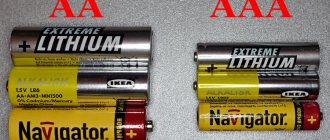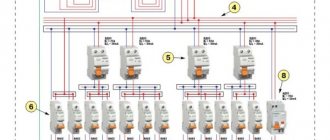What is DC current and what does it mean?
It is customary to call an electric current constant, the strength and direction of which do not change. In electrical engineering, a mixed mode with a predominant constant component is also called constant if the fluctuations are negligible for the intended effect, or if the fluctuations are the result of load fluctuations. Then the arithmetic mean is considered as direct current.
Power lines carry current to homes and businesses
For your information! In English it is usually denoted as Direct Current, or DC for short, which is also used for constant voltage. Alternating current is translated as Alternating Current, which means AC voltage.
"Pure" and "pulsating" direct currents
What is alternating current
The voltage can be either constant or change its instantaneous value in each period of time. In this case, not only the value of the parameter can change, but also its direction. In most cases, alternating current implies a change according to a sinusoidal law and has an alternating value. This is a well-known voltage in household and industrial power supply networks. In a broader sense, voltage can change its value without changing polarity.
Those who are more deeply familiar with electrical engineering can say that in this case we are talking about alternating voltage with some constant component. It is enough to install a capacitor in series in the circuit that does not allow the DC component to pass through, and the output will produce an alternating electric current.
What is the DC voltage?
With DC voltage, electrons always move in one direction. The voltage source thus always has the same polarity. However, the voltage level does not always have to be the same. The classic energy source for generating constant voltage is a conventional battery, in which the voltage level decreases during discharge.
Movement of electrons at constant voltage
In addition, most power supplies also generate DC voltage, although they are supplied with AC voltage. In the case of stabilized power supplies, in addition to the flow direction, great importance is also given to the AC voltage level, which can vary depending on the voltage, but will always have the same polarity.
Note! AC voltages supplied by mains transformers and generators can be converted by rectifiers. Then an electrical voltage arises that varies in magnitude, but not in sign.
Circuits with direct and alternating current
The AC voltage component can be reduced by connecting a large enough smoothing capacitor in parallel or in series with the smoothing coil so that only a small residual ripple remains. The larger the capacitor capacitance or coil inductance, the smaller the peak value of the imposed AC voltage will be.
You may be interested in this Determination of short circuit current
The difference between variable and constant
First of all, DC voltage must be generated at substations with a relatively low voltage to be provided to the consumer (220V). However, when several devices are connected simultaneously, the total value increases. In this situation, to transmit voltage over long distances, it is necessary to use a thick and expensive cable. This is the only way to be able to transport current over long distances with minimal power losses.
In the AC example, the generated electricity is able to travel a long distance with minimal losses. Since 1980, it has become possible to rectify three-phase electric current and convert it back.
The main difference between AC voltage and DC current is that the latter shows comparative stability. By this we mean that it does not change the frequency of the direction of movement.
Healthy! The most common frequency in the world is 50 Hz.
Due to the fact that the movement of direct current flows more uniformly, the direction of electron flow is strictly in one direction. Moreover, the source in this situation has both a positive and a negative pole. Thus, direct current is mainly used in high-voltage lines (for transportation over long distances). After converting to a variable, it is transmitted to our sockets.
Interesting! Before the voltage reaches its destination (consumer), it enters the transformer. Here it is converted from high to lower, with a corresponding lower value, acceptable for use for domestic needs, and transmitted to the apartment or house.
What is the difference between DC current and AC current?
Initially, direct current was supposed to be generated in power plants with a relatively low outlet voltage for the consumer, 110 or 220 V. However, if several consumers are connected with this option, the total values are very high. In this case, thick and expensive cables are required to cover long distances to keep transmission losses within certain limits. When using alternating voltage, the generated electricity can be transported over relatively long distances with little loss. Since 1980, it has been possible to rectify three-phase high voltage current and then convert it back.
The main difference between AC and DC, direct and alternating currents is that the first changes at certain intervals (with a certain frequency), in particular, it changes direction as it flows. The most common frequency in the world is 50 Hz.
Note! When electricity reaches the consumer, then transformers are used. They convert high voltage into lower voltage, which is supplied to homes.
Voltage transformer
As already stated, DC electricity does not change over time. And since electrons only move in one direction, sources are characterized by the presence of positive and negative poles. AC is more efficient when using many kilometers of power lines. And direct current is preferable for small electronics or storage elements, such as solar panels.
Main characteristics of current
When considering the main parameters of this physical quantity, we will immediately make a reservation that the often used term “current strength” is considered by most experts to be not entirely correct. Much more suitable to denote its scalar characteristic is not the force, but the speed (sometimes called intensity) of the movement of free electric charges.
According to the classical concept, this speed is defined as the amount of charge moving through a given cross-section of a conductive material per unit time. It is this indicator, taken as a unit of current, that is called one Ampere.
Thus, a flow of one Ampere is the movement of a charge of one Coulomb through a given conducting section in a time equal to a second. Another characteristic of direct current associated with its flow through a load with resistance R is called voltage drop, which is measured in Volts. It is defined as the potential difference formed across a conductor when one Ampere flows through it.
The same definition can be presented in the following form. One Volt is a potential difference between points spaced apart in an electric field that is sufficient to perform one Joule of work (when transferring a charge of one Coulomb between them).
The practical characteristics of the current component obtained through rectifiers usually include the following parameters:
- The amplitude of pulsations, defined as the difference between its limit values;
- An indicator of ripple, presented as a ratio of two quantities, in which the numerator is AC current, and the denominator is DC.
Let's explore the latter in more detail.
DC component
When examining the shape of the load current at the output of a diode rectifier using an oscilloscope, it is possible to discern its ripples, which appear due to the limited capabilities of the filter components (capacitors).
In some cases, these components are so small that they may not be taken into account when calculating circuits in which filter capacitors should be installed. With this approach to the category, it is more convenient to consider the indicator under study as pulsed or pulsating and to distinguish its two components: DC and ac. Let's look at each of these components in more detail.
Constant DC
The indicated value is calculated as the average value of the current action during the period. It is fundamentally different from another characteristic of a pulsating flow, called the variable component ac.
Variable Component
Alternating current (more precisely, the component of the pulsating current) ac represents a periodic oscillation of its amplitude around the previously discussed average position. When calculating this value, it should be assumed that its value includes the following components:
- Permanent part;
- The value of the variable component (ac), defined as the root mean square value.
Both of them are components of the current signal under study and, like all electrical parameters, have a fixed power (that is, the ability to perform a certain work). The latter is calculated as:
where I is the root mean square constant component and current ripple.
That is, when calculating power, the components of the constant DC and variable ac are summed up as complex quantities.
Additional Information.
They are represented in this case in the form of vector components of the original signal.
It is also important that all the definitions discussed, like the AC and DC symbols, are equally applicable to the “voltage” category.
In conclusion, let us once again draw attention to the fact that the idea of a constant current is most often associated with the invariability of the direction of the flow of free electrons. However, in reality, this concept involves taking into account a number of scalar characteristics, one of which includes the intensity of the flow of charges in a passive load.
When the nominal value of this current component changes over time, it can be considered constant only conditionally, which is allowed within the framework of the problem being solved in each specific case.
Sources of electrical energy
The most common sources are galvanic cells, batteries, and special electrical generators that are based on unipolar induction.
AA battery
Regular AA batteries are the most affordable example of a DC energy source. It has positive and negative poles, and it must be inserted into various electrical devices with a certain side. In addition, solar cells and car batteries are very often used in everyday life.
Note! An electric generator, which is used when higher power is required, always generates alternating voltage. To be able to receive direct current from it, a commutator was previously used. Because switches cause radio interference and their contacts wear out, they are now more often replaced with rectifiers.
You might be interested in this: Features of electrical power
The generator must come with a switch
Designations on diagrams and devices
It is generally accepted that the direction of electricity goes from a contact with a plus sign to a contact with a minus sign.
Places with high potentials are called “positive pole” and are indicated by a + (plus) sign. Points with lower potentials, accordingly, are called the “negative pole” and are designated by the sign - (minus).
Initially, it was accepted that the electrical insulation of positive wires is red, while wires with a minus sign are painted blue or black.
Symbols on electrical appliances: - or =. Unidirectional electricity (including constant electricity) is denoted by the Latin alphabet DC, or the Unicode symbol is used - U+2393.
The abbreviations AC and DC are firmly rooted in everyday use and are used along with the usual names “variable” and “constant”:
- designation of direct voltage (—) or DC (Direct Current);
- alternating current sign (~) or AC (Alternating Current) - designation of alternating current.
Scope of application of DC current
Direct current has wide technical applications in electronics, solar energy generation and partly in railway power supply. Almost all electronic circuits (for example, in computers) work with them. If electronic devices are powered by power supplies other than batteries or accumulators, the rectifier in the power supply provides a constant value. So among the most popular devices are cell phones, laptops and computers.
Circuit boards in a laptop
Solar cells can also only generate DC. If photovoltaic systems are to feed the electrical energy they produce into the public grid, an inverter must be connected between them.
Solar panels
Electric vehicles that have recently become widespread use DC for their operation. It is also used in above-ground and underground public transport, such as trams, trolleybuses and metro trains.
Thus, AC and DC currents have significant differences. It is important to take this into account when connecting this or that equipment, and also so as not to confuse the scope of application.
Application areas of DC voltage
The use of constant voltage allows the electrical energy to be transferred to be increased and then transferred between power systems that use alternating current of different frequencies (for example, 50 and 60 hertz).
Direct current is also actively used in transport. Constantly excited electric motors are used in various mechanisms:
- electric locomotives;
- electric trains;
- trams;
- trolleybuses;
- lifts, etc.
There was also constant tension in other areas of science and technology. It is widely used in this way:
Electricity accompanies us everywhere: at work and at home. It’s scary to even imagine for a minute what will happen to humanity if it suddenly loses electrical energy.
Direct or DC current is a flow of electrical charges that does not change its direction and strength over time, which, according to the classical definition of this quantity, is measured in coulombs per second (or amperes).
When getting acquainted with electrical phenomena of a permanent nature, it is important to remember not only the direction in which physical processes occur, but also their intensity (strength). In actual operating conditions of electrical or electronic equipment, the DC value is rarely absolutely constant.
Problem with voltage rectification
Although conceptually simple, rectifying incoming AC current adds a whole host of problems to your power supply. Most rectifiers are made using conventional diodes. These diodes will create ripple when switching during operation, which creates higher harmonics in the AC power supply. They will also have a forward voltage drop (although it is small) which dissipates energy into heat.
You can use a MOSFET bridge rectifier to rectify the incoming AC voltage, but the rectifier is much more complex and expensive than a diode rectifier. Let's look at a small example for the Nest thermostat, which is powered by the 24 VAC used for regular thermostats. This is a real problem because turning on the heater or air conditioner is based on closing the 24V AC circuit in the thermostat - this is how a regular thermostat works. The connector draws very little current to charge its batteries. It can then short-circuit the 24VAC input to turn on the heater using the same transistor bridge while it is running on batteries. The Nest thermostat needs every “little bit of energy” it can store, hence the need to eliminate the simple diode bridge.
AC rectification has other problems such as the surge current that occurs during the rectification process (picture below). This is different from the inrush current that DC supplies have when you first apply power to them. Current surges occur because rectifier diodes can only operate when the AC input voltage is greater than the DC voltage. This means that there is a short burst of current only at AC voltage peaks, resulting in a decrease in the power factor of the AC source. Power factor is a kind of measure of the consistency of voltage and current supplied by an AC line.
For inductive loads such as electric motors, the AC current will lag behind the AC voltage. For a capacitive load, it’s the other way around—the current leads the voltage. In both cases, the voltage and current are out of phase, so the power factor is below the ideal value of “1”. When rectifying, the power factor drops for another reason. Although current surges can be in phase with voltage, this only occurs for a short period of time on the AC signal.











